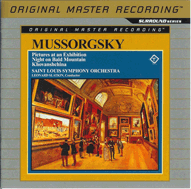
My expectations for Mobile Fidelity Sound Lab’s re-release of a 1975 recording was shadowed by my past experiences with all other label’s similar attempts. Then, before I listened to the hybrid SACD, names of the companies that assisted in the creation of this disc was printed on the back cover of the MoFi disc, rekindling a spark of hope in me:
Tim de Paravicini, Edmund Meitner, Pass Labs, Silverline Audio, Sound Application, EgglestonWorks, Clearaudio, Aesthetix, Stax Electrostatic, LINN & Z-Systems.
I have Linn’s Klimax Twin solid-state power amplifier and Z-Systems’ RDP-1 Reference Digital Preamplifier, so I became enthusiastic about the potential advantages these two names alone would contribute to the sound of the recording. The accompanying booklet’s inner page further tells about the recording process from the viewpoint of the original engineer, Marc Aubort (see sidebar).
Slatkin’s version of the Pictures At An Exhibition has a rather thoughtful arrangement that fosters listener involvement, one that is not inundated with over-indulgence from either the conductor or his players. This intelligent and masterful reading of the work favors equal objectivity on the part of the listener, and you may soon find it rewarding as repeated listening brings greater and more insights.
In terms of duration, this MoFi version is substantially shorter than my favorite disc by von Karajan of Deutsche Grammophon, a master of precision interpretation. The Telarc disc, of course, continues to the be record holder of the fastest playing of the piece.
The brilliance of this disc is the Night On Bald Mountain, in which Slatkin and St. Louis Symphony conjured up an impeccable tempo that served all purposes: continuity of speed in depiction of the orgy, lustrous tonality and a superb playing that is rich in details.
Nearly two decades ago, Telarc’s version took the audiophile world by storm for its wild dynamics and unprecedented bottom-end definition. Its unrelenting tempo was fun to listen to, while reminded me of the disco version from “Saturday Night Fever”. At that time, Lorin Maazel’s version was the fastest and wildest. It still is.
Slatkin’s MoFi disc surpassed the Maazel standard by reasserting a more unified tempo which accorded the virtuosic players of the St. Louis Symphony a platform for a most coherent and fluidic performance. Slatkin nearly exerted a Germanic-like discipline and precision upon his players, imparting newfound subtlety in the contrasts among instrument groups without sacrificing the agility of the ensemble as a whole.
To my ears, the MoFi presentation is more firmly rooted in the classical tradition, with less frantic overall pacing and none of the abrupt swing of pacing when compared to the renowned Telarc/Lorin Maazel version. On top of that, the freshness of the St. Louis Symphony’s playing was both lingering and powerful. Upon the third playing of this disc in 48 hours, I continued to find every minute of music from the MoFi disc intensely tasteful and devoid of boredom.
Among the last four tracks on the MoFi disc, Mussorgsky’s Dance of the Persian Slaves from his epic opera, Khovanshchina, harnessed the most haunting score, even more so than his Night on Bald Mountain. Reminding me of Jean Sibelius’ beautiful but starkly melancholy Valse Triste, Dance of the Persian Slaves was more subdued in the emotional outcry; but otherwise comparably exotic and stimulating. Running at a little over six minutes, it simply ended too soon.
This MoFi disc competes with offerings from the likes of Deutsche Grammophon in performance, and with Paul Stubblebine mastering the DSD transfer using MFSL’s proprietory GAIN 2 technology, who also works on releases from Seattle-based audiophile label First Impression Music, this MoFi disc just got a new lease in life.
Review System:
47 Laboratory 4704 PiTracer CD transport with two Power Humpties
Harmonix Reimyo DAP-777 20bitK2 DAC
Loth X JI300 integrated 300B amplifier
Tannoy Churchill Wideband loudspeaker
Via Audio Note Sogon digital cable, Sogon interconnects, AN-Vx
interconnects, AN-SPx speaker cable
- (Page 1 of 1)

i have to disagree that the Maazel version is surpassed by Slatkin’s. to my mind, the tempos and musicianship are best found on the Telarc/Maazel release.